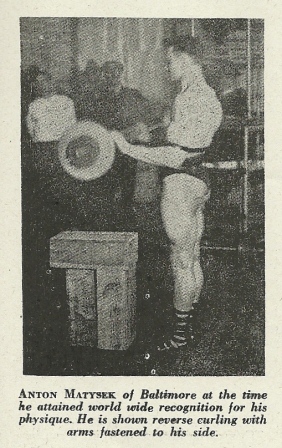Reverse Curl (Curl – Reverse Grip)
by Al Myers

The strict Reverse Curl has a long tradition of being an All-Round Lift. This picture was published in a 1946 issue of Strength and Health.
Over this next week I’m going to highlight each lift that will be contested at the 2012 IAWA World Championships in Salina, Kansas on October 6th and 7th. The total lifts contested is 7 – 4 on day 1 and 3 on day 2. It is a good mix of lifts to test the all round strength of any lifter. The order in which the following list is listed is the order these lifts will be contested on meet day.
Lifts on Day 1:
Reverse Curl (Curl – Reverse Grip)
One Hand Clean and Jerk (Clean and Jerk – One Arm)
Pullover and Press on Floor (Pullover and Press)
Steinborn (Steinborn Lift)
Lifts on Day 2:
Two Hands Snatch – 2 Inch Bar (Snatch – Fulton Bar)
One Hand Hacklift (Hack Lift – One Arm)
Straddle Deadlift (Jefferson Lift)
You may notice that each lift has 2 names. The reason for this is that the IAWA rulebook has different names for several of the lifts than the USAWA rulebook. The first name listed is the IAWA name while the second name (the one in parenthesis) is the USAWA name. It is important to know that for this meet the IAWA rules for the individual lifts will be followed instead of the USAWA rules since this is an IAWA event. The following is the IAWA rule for the Reverse Curl:
E32 REVERSE CURL
The rules of performance for the rectangular fix apply, except that once the curled bar reaches the midway point, it does not stop fixed, but continues in one movement, until the bar is at the top of the sternum / neck configuration.
Causes for Failure:
1. Starting to lift before the referees signal.
2. The causes for failure are the same as for the rectangular fix, except that once curled the bar continues upwards to a finished position at the sternum / neck configuration.
3. Any stopping or lowering of the bar on its upward journey.
4. Lowering / replacing the bar before the referees signal.
E3 RECTANGULAR FIX
The barbell should be held at arms length, resting across the lifters thighs with the legs and body upright and erect. With a hand grip spacing of no more than shoulder width, and with the knuckles facing the front, the referee will signal to start the lift. With the upper arms remaining held in contact with the torso, the lower forearms will raise, holding the bar firm (not sagging at the wrist) until they are at right angles to the body and parallel to the floor. No raising of the heels and toes, or swaying of the body is allowed. When the bar is held fixed and motionless in the finished position, the referee will signal to replace the bar.
Causes for Failure:
1. Starting the lift prior to the referees signal.
2. Failure to hold the bar in the fixed, finished position, forearms at right angles to the body and parallel to the floor, until the referees completion signal.
3. Any movement of the feet or swaying of the body during the lift.
4. Failing to keep the legs and torso braced, upright and erect during the lift.
5. Failure to keep the upper arms in contact with the torso throughout, or allowing wrists to sag.
The USAWA Rule for this lift (Curl – Reverse Grip) is the same, but just worded differently. However, it is important to know that the USAWA does have a similar lift (Curl – Cheat, Reverse Grip) that follows the rule of the Cheat Curl instead of the Rectangular Fix. That lift is NOT the one being contested!!! I’m reinforcing this point because the Curl – Cheat, Reverse Grip was contested at this past USAWA National Championships, and by that, could cause confusion!